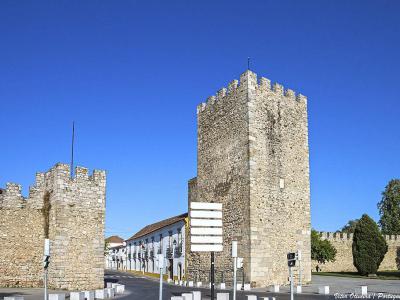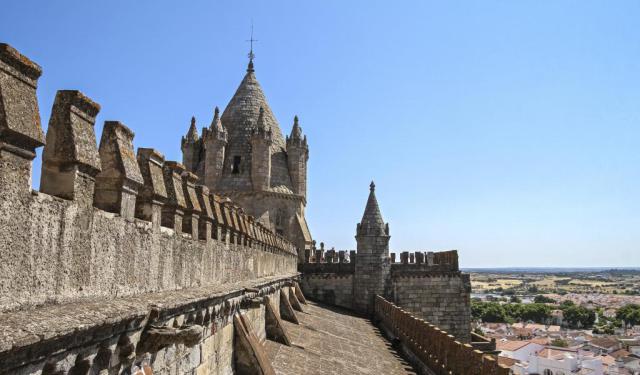
Muralhas de Evora (Walls of Evora), Evora
The Walls of Évora form an integral part of the city's Historic Center, earning the esteemed status of a UNESCO World Heritage Site and receiving recognition as a National Monument since 1922.
This defensive marvel is a fusion of architectural styles and historical periods, reflecting the city's diverse past. The earliest incarnation of the walls dates back to the 3rd century, during the era of Roman influence and expansion. Constructed during the Romanization period, this initial defensive boundary encompassed a sprawling area of around ten hectares and spanned an impressive length of nearly two thousand meters. The Porta de D. Isabel, also known as the Roman Arch of Évora, stands as an enduring legacy from this period, a portal to the city's past.
As history evolved, so did the walls. From the days of the Visigothic reign, a monumental presence emerges in the form of the quadrangular Tower, often referred to as the Tower of Sisebuto. This tower, attributed to King Sisebuto who ruled in the 7th century, anchors the walls with a tangible connection to that era. Despite the passage of time, the exact transformations that occurred during this period remain shrouded in mystery, leaving only tantalizing traces of the walls' evolution.
With the Islamic period weaving its influence through the city's chronicles, the walls too underwent changes, although these transformations are obscured by the mists of time. Echoes of this era persist in remnants scattered discreetly around the Cathedral and the Roman Temple, whispering tales of a bygone era.
This defensive marvel is a fusion of architectural styles and historical periods, reflecting the city's diverse past. The earliest incarnation of the walls dates back to the 3rd century, during the era of Roman influence and expansion. Constructed during the Romanization period, this initial defensive boundary encompassed a sprawling area of around ten hectares and spanned an impressive length of nearly two thousand meters. The Porta de D. Isabel, also known as the Roman Arch of Évora, stands as an enduring legacy from this period, a portal to the city's past.
As history evolved, so did the walls. From the days of the Visigothic reign, a monumental presence emerges in the form of the quadrangular Tower, often referred to as the Tower of Sisebuto. This tower, attributed to King Sisebuto who ruled in the 7th century, anchors the walls with a tangible connection to that era. Despite the passage of time, the exact transformations that occurred during this period remain shrouded in mystery, leaving only tantalizing traces of the walls' evolution.
With the Islamic period weaving its influence through the city's chronicles, the walls too underwent changes, although these transformations are obscured by the mists of time. Echoes of this era persist in remnants scattered discreetly around the Cathedral and the Roman Temple, whispering tales of a bygone era.
Want to visit this sight? Check out these Self-Guided Walking Tours in Evora. Alternatively, you can download the mobile app "GPSmyCity: Walks in 1K+ Cities" from Apple App Store or Google Play Store. The app turns your mobile device to a personal tour guide and it works offline, so no data plan is needed when traveling abroad.
Muralhas de Evora (Walls of Evora) on Map
Sight Name: Muralhas de Evora (Walls of Evora)
Sight Location: Evora, Portugal (See walking tours in Evora)
Sight Type: Attraction/Landmark
Guide(s) Containing This Sight:
Sight Location: Evora, Portugal (See walking tours in Evora)
Sight Type: Attraction/Landmark
Guide(s) Containing This Sight:
Walking Tours in Evora, Portugal
Create Your Own Walk in Evora
Creating your own self-guided walk in Evora is easy and fun. Choose the city attractions that you want to see and a walk route map will be created just for you. You can even set your hotel as the start point of the walk.
Evora Introduction Walking Tour
Nestling in the sun-drenched Alentejo region of Portugal, Évora is a timeless gem in the heart of the country and one of its oldest and most enchanting cities.
The city's history spans over 5,000 years. The name Évora originates from the Celtic word "ebura," which means "of the yew trees."
The Romans conquered the place in 57 BC, shaping it into a vital town at... view more
Tour Duration: 2 Hour(s)
Travel Distance: 3.3 Km or 2.1 Miles
The city's history spans over 5,000 years. The name Évora originates from the Celtic word "ebura," which means "of the yew trees."
The Romans conquered the place in 57 BC, shaping it into a vital town at... view more
Tour Duration: 2 Hour(s)
Travel Distance: 3.3 Km or 2.1 Miles

